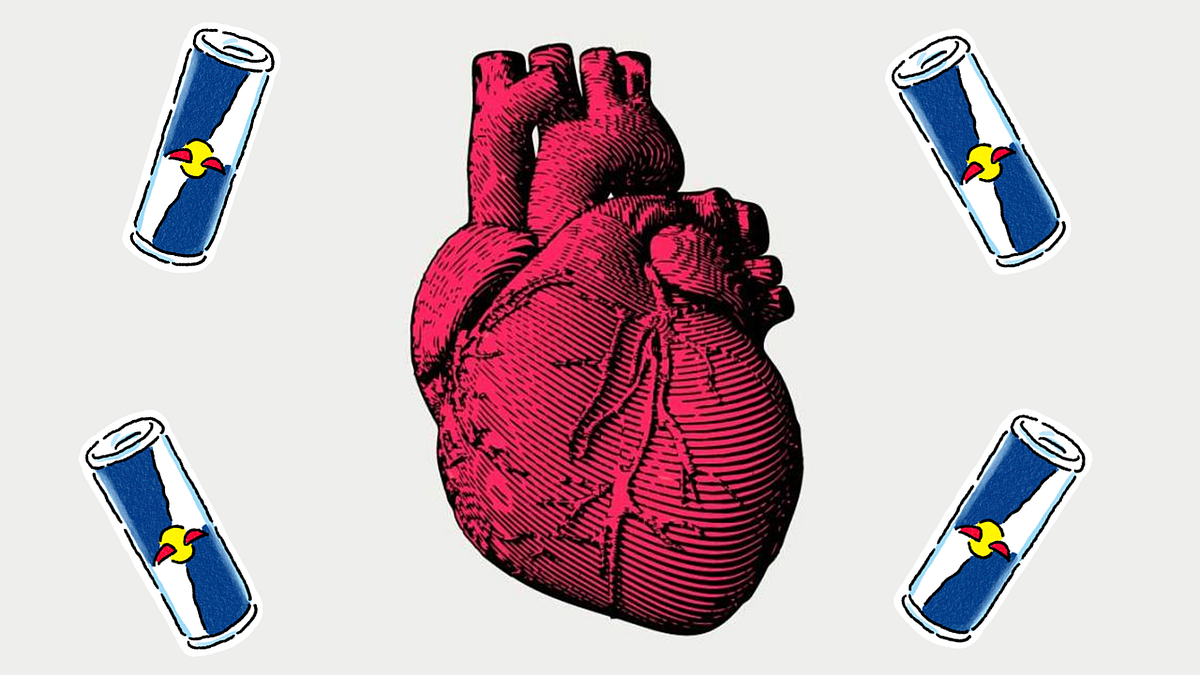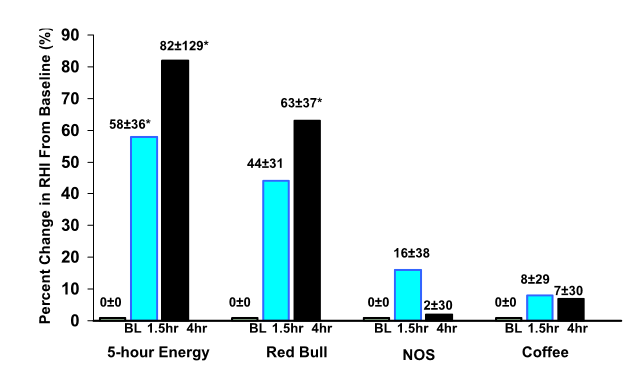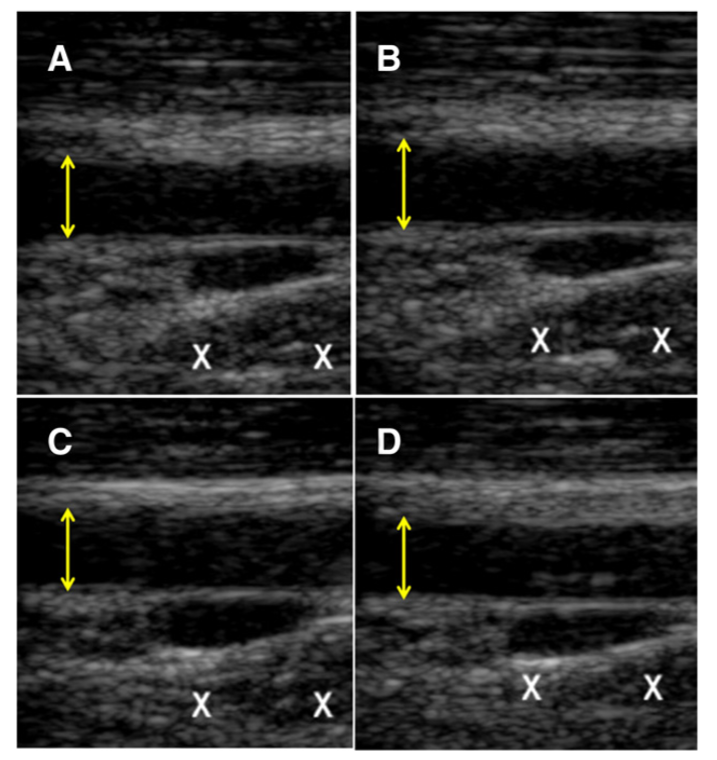
Of all the beverages consumed throughout the world, coffee, tea, and soda probably make up a large proportion (other than water and alcohol).
Among athletes, gamers, college students, and (mostly) younger boys/men, energy drinks are also a popular beverage. In fact, between 2003 and 2016, energy drink consumption grew considerably among adolescent, young, and middle-aged adults in the U.S.
There have been several published position statements debating the relative benefits and harms of energy drinks. This has partially stemmed from case-reports involving adverse cardiovascular events (including some fatalities) following high-dose energy drink consumption; sometimes after the consumers mixed them with alcohol.

While rare, these events cause concern among consumers and public health professionals, as well as cardiologists and sports doctors. Should energy drinks be banned? Should we limit their sales to “underage” consumers who might abuse these beverages or be at an increased risk? What is a safe “dose” of an energy drink…if there is a “safe” dose?
Before reviewing some studies, it might be relevant to ask: what are “energy drinks”? I have always found the term a misnomer because really, what is “energy” but calories that we obtain from food? In this sense, all calorie-containing food and beverage is “energy providing”…but I digress.
Energy drinks (Monster, Rockstar, Red Bull, etc.) are marketed for their ability to enhance physical ability, cognitive function, and athletic performance. Whether it’s reaction time, your 100 meter sprint, or conquering the final level of a video game — energy drinks supposedly will help you do it better, faster, and with less effort. Extreme sports like BMX and skateboarding are also among activities targeted by energy drink campaigns.
Where does this “energy” boost in an “energy drink” come from? Well, most energy drinks have myriad ingredients formulated in a “proprietary blend” of performance-boosting vitamins and herbs. Popular ingredients include: L-Carnitine, Guarana, Glucuronolactone, Taurine, Ginseng, B-Vitamins (Riboflavin; B2, Niacin; B3, Pyridoxine; B6, Folate; B9, Inositol; B8, Cobalamin; B12), glucose (sugar), and caffeine.
Most of these ingredients have been studied, more or less, for their ability to enhance some aspect of performance or cognitive function. Interestingly, the only ingredient(s) that are consistently shown to provide any performance improvement are caffeine and glucose.
Sure, there is the occasional study showing that B12 supplements or Ginseng can boost mental and physical performance, but the literature is far from conclusive, and many of these studies are poorly controlled. As far as your body and brain are concerned, sugar and caffeine are providing most of the relevant benefits.
But this article isn’t about performance — it’s about safety.
In particular, due to the potential adverse cardiovascular side effects of energy drinks including irregular heart rhythms (arrhythmias), blood clotting, or myocardial infarction (heart attack), there has been a considerable interest in studying the effects of energy drinks on blood vessel health and function — how they affect arteries, veins, and blood. This could tell a lot about HOW energy drinks might be manifesting their cardiovascular effects.
In addition, studying this important topic will help play a role in public health recommendations and guidelines surrounding the usage of energy drinks.

The gold-standard way to measure the effect of any intervention (i.e. energy drink consumption) on physiology is to use a randomized, placebo-controlled study (known as a randomized-controlled trial or RCT). This means that participants don’t know what beverage they are receiving, consume an “inactive” placebo beverage at least once, and consume them in a randomized order on different visits. Studies utilizing this design can state that their results are valid with more confidence than those not utilizing a placebo.
There are several published RCTs investigating the effects of energy drinks on blood vessel function — what I’ll refer to as vascular or endothelial function in the remainder of this article.
In a study published in the American Journal of Medicine (Worthley 2009), 50 healthy volunteers (34 males with average age of 22) had endothelial function and platelet aggregation (blood clotting) measured 60 minutes after consuming a sugar-free energy drink (Red Bull) or a placebo (carbonated water). Red Bull caused a significant increase in platelet aggregation and a reduction in microvascular endothelial function. Blood pressure also increased, but this is a consistent result of caffeine-containing beverages, and not necessarily surprising.

Another study published in the European Journal of Nutrition (Grasser 2014) evaluated the effects of Red Bull energy drink (114mg caffeine) on microvascular endothelial function in 25 healthy adults (13 males with an average age of 23). Interestingly, 2 hours after consuming the drink, microvascular function improved compared to baseline function.
The endothelial effects of Red Bull (80mg caffeine) were also evaluated in a study (Molnar 2015) alongside other “energy beverages” including 5-Hour Energy (230mg caffeine), NOS energy drink (120mg caffeine), and coffee (240mg caffeine). This study involved males and females with an average age of 25.
Endothelial function was measured 1.5 hours and 4 hours after drink consumption — a bit longer timeline than many of the previous studies.
Interestingly, 5-Hour Energy and Red Bull improved endothelial function at 1.5 hours by 58% and 44% and at 4 hours by 82% and 63%, respectively. Consuming coffee and NOS, however, did not lead to any significant changes in endothelial function.

The above study is interesting because it does not implicate caffeine as the main mediator of the improvement in endothelial function with energy drinks. In this study, the coffee beverage had the highest amount of caffeine, but resulted in no functional improvements, while Red Bull, containing the least amount of caffeine, improved microvascular function. Thus, there is the potential that other ingredients (Taurine, perhaps) could have cardiovascular benefits when consumed as part of an energy drink. But, this needs to be studied further.
Two studies have investigated energy drinks in regards to their effects on the gold-standard measurement of large-artery function in humans — brachial-artery flow-mediated dilation (FMD). One, published in in the World Journal of Cardiology (Higgins 2017), gave healthy medical students 24oz of Monster energy drink and measured vascular endothelial function 90 minutes later. FMD was reduced from 5.9% at baseline to 1.9% after consuming the energy drink, indicating an impairment in endothelial function.

A case study (1 participant) published in the International Journal of Cardiology (Higgins 2013) provides more evidence that acute consumption of an energy drink may impair endothelial function. On a single occasion, a 47-year old man consumed 24oz of a Monster energy drink and 50 and 90 minutes later, endothelial function was measured using FMD. Endothelial function was worse at both 50 and 90 minutes post consumption. Of note, the man also showed signs of QTc interval prolongation on his electrocardiogram (ECG) — which is a sign of abnormal heart activity.

In general, it is hard to make firm conclusions about whether or not energy drinks are harmful, per se, based on results from these studies. This is due to a variety of reasons.
In particular, studies use varying types of energy drinks (sweetened vs. sugar free), different levels of caffeine (80–240mg), different time points, and even different brands of energy drinks. This makes it hard to generalize the effect of say, Red Bull, on endothelial function.
However, there does seem to be a trend for endothelial function to decline shortly after consuming an energy beverage. This could potentially mean that at doses over and above those studied, energy drinks could disrupt vascular function in the short term. This seems to occur about 60–90 minutes after consumption, but may even last up to 4 hours.
The reasons for this are unknown, but a few ingredients may be the “culprits.” Energy drinks contain ALOT of sugar, and acute increases in blood glucose are known to impair endothelial function. However, even sugar-free energy drinks may reduce endothelial function.
Caffeine, present in all energy drinks, could also be responsible. The effects of caffeine on endothelial function are also inconclusive — some studies report improvements while others report reductions. This may depend, in part, on the habitual caffeine consumption of the study participants — something that (unfortunately) many studies fail to report (and likely don’t even track).
We also have to think about how energy drinks are administered in experimental settings vs. a “real-life” scenario. Lab-based studies require participants to consume the beverage(s) and then sit or lie quietly for the remainder of the study. Out in the real world, energy drinks are consumed in relation to sporting events, exercise, or other activity. Whether or not this would exacerbate the negative effects is unknown. However, many claim that the increased stress of heavy exercise in conjunction with energy drink consumption may heighten cardiovascular risk.
Nonetheless, I’m of the opinion that, in their “recommended” dose (meaning a single can or serving), energy drinks/caffeine are likely not too harmful. A dose of caffeine around 200mg is most likely well-tolerated by all and unlikely to induce significant adverse cardiovascular side effects.
Ingredients like Taurine, B-Vitamins, Ginseng, and other herbs could also provide some significant albeit minute benefit to physiology as a nutritional supplement. For this reason, energy drinks might also not be as bad as they are purported to be.
I, for one, have never taken to energy drinks, preferring coffee or some type of caffeine pill instead to get my “energy” fix. Most energy drinks are just enhanced soda, and I’d prefer to stay away. Newer, healthier alternatives exist, which could be a good low-sugar option for people wanting a multi-ingredient performance beverage with minimal side effects for metabolic or cardiovascular health.
If you want to indulge in one or two energy drinks per week for some extra pep, and if you find that they actually “work” for you, there’s likely no reason to avoid these products. But be aware of dosing, and observe how your body responds. As with all things in nutrition and physiology, individual variability exists in tolerance and efficacy. Energy drinks are no exception.

References
Vercammen KA, Koma JW, Bleich SN. Trends in Energy Drink Consumption Among U.S. Adolescents and Adults, 2003–2016. Am J Prev Med. 2019;56(6):827–833.
Higgins JP, Ortiz BL (2014) Energy Drink Ingredients and their Effect on Endothelial Function: A Review.Int J Clin Cardiol 1:006
Worthley MI, Prabhu A, De sciscio P, Schultz C, Sanders P, Willoughby SR. Detrimental effects of energy drink consumption on platelet and endothelial function. Am J Med. 2010;123(2):184–7.
Grasser EK, Yepuri G, Dulloo AG, Montani JP. Cardio- and cerebrovascular responses to the energy drink Red Bull in young adults: a randomized cross-over study. Eur J Nutr. 2014;53(7):1561–71.
Molnar J, Somberg JC. Evaluation of the Effects of Different Energy Drinks and Coffee on Endothelial Function. Am J Cardiol. 2015;116(9):1457–60.
Higgins JP, Yang B, Herrin NE, et al. Consumption of energy beverage is associated with attenuation of arterial endothelial flow-mediated dilatation. World J Cardiol. 2017;9(2):162–166.
Higgins JP. Endothelial function acutely worse after drinking energy beverage. Int J Cardiol. 2013;168(2):e47–9.

